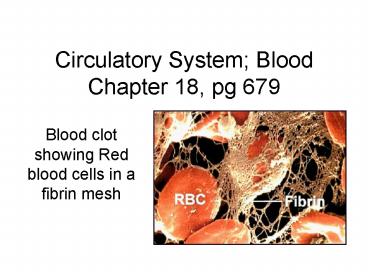Circulatory System Blood Chapter 18, pg 679 - PowerPoint PPT Presentation
1 / 17
Title:
Circulatory System Blood Chapter 18, pg 679
Description:
... of 45. The RBC layer together with the 'buffy coat' layer ... First one is okay, the body hasn't made any Anti-D antibodies. Second one can cause problems ... – PowerPoint PPT presentation
Number of Views:94
Avg rating:3.0/5.0
Title: Circulatory System Blood Chapter 18, pg 679
1
Circulatory System BloodChapter 18, pg 679
- Blood clot showing Red blood cells in a fibrin
mesh
2
(No Transcript)
3
The basics, functions and properties
- People have 4-6 L of blood
- Two components include
- Plasma clear fluid
- Cells Platelets
- Erythrocytes (RBCs)
- Leukocytes (WBCs)
- Centrifuging blood separates the two parts
- RBCs make up 45 of volume, a number called the
hematocrit - RBCs make blood 4xs as viscous as water
4
Blood Components
- This test tube shows the components of blood in
their relative ratios. It shows a hematocrit of
45. The RBC layer together with the "buffy coat"
layer make up 45 of the total volume of
centrifuged blood (4.5 m. out of 10 ml). - hematocrit of a normal adult male
47 adult female 42
5
Plasma
- Serum Like plasma but, without clotting proteins
- Proteins of Plasma
- Albumins smallest most abundant
- Regulates osmotic pressure
- Globulins alpha, beta, and gamma
- make up antibodies
- Fibrogen allows clotting
- Nitrogenous wastes in plasma (urea) are excreted
in the kidneys
6
Erythrocytes (RBCs)
- O2 CO2 carrier
- Determine bloodtype
- Need to be resilient to get through capillaries
- Hemoglobins make up 33 of the cytoplasm
- Nucleus is lost during cell formation
7
Qualities of Erythrocytes
- RBC count (Hematocrit) tells how much O2 blood
carries - Why women have lower hematocrits
- Androgens stimulate RBC production
- Menstrual loss
- Inverse proportion to body fat
- Males also clot faster.
- What evolutionary significance might this have?
8
Erythrocyte Disorders
- Polycythemia Excess RBC
- Anemia RBC Shortage
- Sickle Cell 1.3 of African Americans
- Symptoms aches in joints from clogged
capillaries, some associated symptoms can be fatal
9
Blood Types
- Antigens on RBC surface allow antibodies to
recognize what is and what is not us - ABO blood group is a multiple allele explanation
of blood types
10
The ABO Blood grizzoup
11
Blood Compatibility
- Agglutination happens when antibodies attack
foreign RBCs - AB is called the universal recipient because it
has no RBC antibodies - But the donors Antibodies can attack the
recipients - Also one of the rarer blood types
- O is the universal donor
12
Rh Groups
- Named for Rhesus Monkey
- 3 genes, C, D, and E, each with two alleles
- DD, or Dd have D antigens on RBCs,
- Classified as Rh
- Rh- lack D antigens
- Combined with ABO group to get Blood types like A
positive or B negative
13
Rh Transfusion problems
- If Rh- person recieves Rh blood
- First one is okay, the body hasnt made any
Anti-D antibodies - Second one can cause problems
- With fetuses with different Rh groups
- The pregnancy is fine as long as there is no
tearing of the placenta - Then the baby might be born with Hemolytic
disease of the new born (HDN), a type of anemia
14
Other Blood groups
- 100 others, and 500 antigens
- MN, Duffy, Kell, Kidd, and Lewis groups
- Rarely cause transfusion problems
- Useful in paternity cases
15
Leukocytes
- White blood cells
- Have nuclei
- Different types are noted by shape of nucleus
- Grainy appearance when stained
16
WBCs
- Neutrophils
- Make up the largest of WBCs
- Releases antimicrobial chemicals
- A high count is a sign of bacterial infection
- Lymphocytes
- About 1/3 of WBCs
- Fights foreign bodies
- Secretes antibodies
17
Leukemia
- Leukemia is cancer of the blood cells.
- body produces large numbers of abnormal WBCs
- Symptoms
- Fever, chills and other flu-like symptoms
- Weakness and fatigue
- Loss of appetite and/or weight
- Swollen or tender lymph nodes, liver or spleen
- Easy bleeding or bruising
- Tiny red spots (called petechiae) under the skin
- Swollen or bleeding gums
- Sweating, especially at night
- Bone or joint pain
- Treatments
- Chemotherapy
- Radiation therapy
- Antibody therapy
- Bone Marrow Transplants
- Also a feline variant

